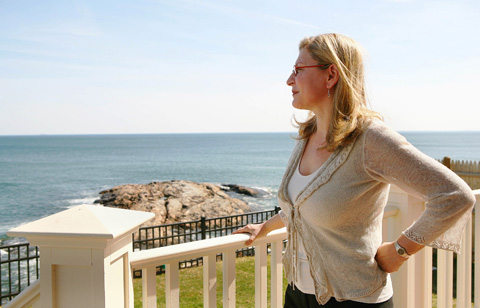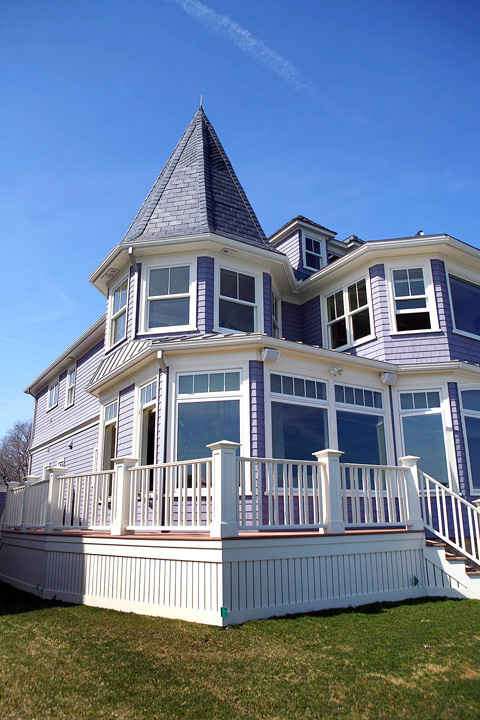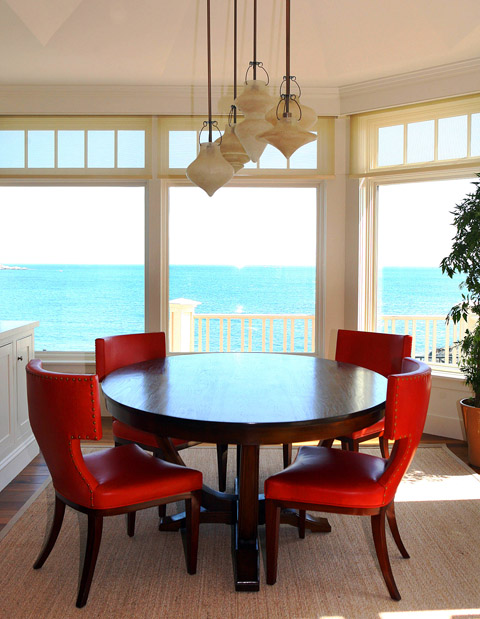Barbara Goldman is no garden-variety environmentalist. When she rehabbed her luxury ocean-front home recently, she insisted that it be eco-sensitive from the basement to the rooftop.
That’s not an easy assignment when green supplies typically cost more and can be harder to find. But Goldman was not deterred.
Consider her roof (recycled rubber), her kitchen counter (Silestone) and her floors (a domestic walnut harvested from old trees that were about to die). Her Bosch washing machine, depending on the load, can use a mere eight liters of water. Her pipes are cast iron, not plastic.

PHOTO: NY Times News Service
“I don’t claim to be a purist,” said Goldman, a 45-year-old attorney. “I don’t eat all organic. I still wear nail polish. I’ve just chosen one area of my life, my house, to make a difference. If we can be an example for other projects, that’s a great thing.”
Eco-friendly construction materials, from solar energy to recycled wood, have been buzzwords since the 1970s. But until recently, green building has been most popular on the commercial level, not so much on the residential side. “There’s more opportunity for saving resources when you’re dealing with a 50-story office tower than a single home,” said Paul Marquis, education coordinator for the NEXUS Green Building Resource Center in Boston, a project of the nonprofit Green Roundtable.
But with today’s rising energy costs and environmental concerns, the residential market is coming around.

PHOTO: NY TIMES NEWS SERVICE
“In the past six months, interest in green residential homes has really taken off,” said Marquis, who has seen 5,000 visitors come to view green samples at his Downtown Crossing reference library since it opened in February 2007. “The market drivers are the soaring costs of energy and a recognition that global warming is a problem we need to address.”
For the first time last fall, the nonprofit US Green Building Council established LEED certification (leadership in energy and environmental design) for residential homes. The national rating system for green building design and construction has been in place for commercial spaces since 2000.
To date, there are 548 LEED-certified homes in the US, including 19 in the state of Massachusetts.

PHOTO: NY TIMES NEWS SERVICE
Goldman, whose home just received its LEED certification, began the gut renovation of her home shortly after she and her husband purchased their 138-year-old, three-bedroom Victorian home in August of 2005. The 600m2 house, which has five bathrooms and an elevator, overlooks the ocean.
Goldman’s top priorities were energy efficiency and indoor air quality. “It was important for us, if we were going to be on the water, that we felt warm. The previous owners completely obscured their view. The windows were covered and it was dark. In my opinion, it was because it was so cold in here.”
Given rising energy costs, the couple pulled out the existing electrical and heating systems. “We figured how could we not explore alternative energy?” she said.
What followed was quite an exploration. She settled on a geothermal heating system, which meant drilling two 150m wells in the yard. The heating system has six zones so only the occupied sections of the house are heated. A radiant heating system warms the first floor. The walls are insulated with Icynene (a foam insulation that is applied as a liquid and then expands to fill every crevice).
Goldman’s insistence on indoor air quality got her thinking about the chemicals in the paint she was using, the glue in the kitchen cabinetry, the varnishes on the floors, and the upholstery on her furniture.
“I am a breast cancer survivor,” said Goldman. “I started thinking that if we were insulating the house well, my system might be assaulted by all sorts of chemicals that we were bringing in. So I started asking questions about every single thing I was purchasing.”
After meeting with several architecture and interior design firms, Goldman enlisted the help of Boston-based Heather G. Wells. “I wanted a team approach and she could provide that,” Goldman said. “We were operating on two tracks simultaneously, the architecture and the interior design.”
The project was a challenge for the firm, which had never before attempted to make a residential home LEED certified. “Everything we touched we had to give some thought to,” said Wells, an architect and interior designer.
“We used a lot of our normal vendors but we needed to talk to them about it,” she said. “We had to ask: ‘What’s in this?’ They didn’t even know. It’s not on everybody’s consciousness yet. There’s stuff out there. You just have to push people.”
Janine Dowling, an interior designer for Wells, said she did much of her research for the project on the Internet on sites such as carpet-rug.org, whitelotus.net and staplescabinetmakers.com.
“I had to educate myself. What are the worst offenders in a house for VOCs [volatile organic compounds that can vaporize and enter an atmosphere]?” she said. “Paint, carpeting, and mattresses. Many mattresses are sprayed with formaldehyde as a fire retardant. Carpeting can be coated in toxins. And we are so used to having the benefits of chemicals in our paint finishes.”
The team turned to Benjamin Moore’s low-VOC Aura line for paint. It also used the water-based glaze Glacis by Adicolor for cabinets in the master bedroom closet, a bathroom and mudroom. In Goldman’s two teenage boys’ bedrooms, she used Flor carpet tiles made of natural fibers. To polish up her walnut floors, she used tung oil as a stain.
Despite her best green efforts, Goldman wasn’t always successful. The Wells team, for example, was not able to find purple organic mohair for the sofas in the living room at a reasonable price.
“We shopped every vendor looking for the particular shade she wanted,” Dowling said. “We could not match what she wanted in her head. When it comes to the tippy-top high end, it’s hard to find a green line. Chemicals add a lot of stability in color. As far as I know, there aren’t any sustainable mohairs yet.”
Dowling could have had it made, she added, but it would have cost about US$400 a meter. They needed roughly 40m of fabric. Instead, the team settled on regular mohair, which cost about US$70 a meter. “You can’t control everything,” she said.
Goldman, who moved into the home in December, couldn’t be happier. “I am very proud of the way the house has come out,” she said. “It smells good. It feels good.”
Not everyone is impressed with projects like Goldman’s. Paul Eldrenkamp, president of Byggmeister, a remodeling contractor in Newton, Massachusetts, said consumers need to be careful about how they define green.
“Any 6,000-square-foot house [560 m2] is going to be a light shade of green. It’s too big to be efficient,” said Eldrenkamp, who has not seen the Goldman house.
Green features like a deck made of recycled materials or bathroom floors made of natural stone are nice, he said, but 20 years from now energy consumption will have the most environmental impact. “From a carbon footprint perspective, it’s most important to minimize the costs required to heat and cool a house,” he said.
Still, Goldman says all winter her family only used the first floor’s radiant heating system to warm the entire house. They never turned on the geo-thermal blowers. “We were very comfortable,” she said.
For all her efforts, Goldman doesn’t expect everyone to go as green as she has. “Since everything in my home was going to be new and fresh, I figured I had an opportunity,” she said. “Everybody has to do what they feel comfortable doing. It is a process.”

Last week the story of the giant illegal crater dug in Kaohsiung’s Meinong District (美濃) emerged into the public consciousness. The site was used for sand and gravel extraction, and then filled with construction waste. Locals referred to it sardonically as the “Meinong Grand Canyon,” according to media reports, because it was 2 hectares in length and 10 meters deep. The land involved included both state-owned and local farm land. Local media said that the site had generated NT$300 million in profits, against fines of a few million and the loss of some excavators. OFFICIAL CORRUPTION? The site had been seized

Next week, candidates will officially register to run for chair of the Chinese Nationalist Party (KMT). By the end of Friday, we will know who has registered for the Oct. 18 election. The number of declared candidates has been fluctuating daily. Some candidates registering may be disqualified, so the final list may be in flux for weeks. The list of likely candidates ranges from deep blue to deeper blue to deepest blue, bordering on red (pro-Chinese Communist Party, CCP). Unless current Chairman Eric Chu (朱立倫) can be convinced to run for re-election, the party looks likely to shift towards more hardline

Sept. 15 to Sept. 21 A Bhutanese princess caught at Taoyuan Airport with 22 rhino horns — worth about NT$31 million today — might have been just another curious front-page story. But the Sept. 17, 1993 incident came at a sensitive moment. Taiwan, dubbed “Die-wan” by the British conservationist group Environmental Investigation Agency (EIA), was under international fire for being a major hub for rhino horn. Just 10 days earlier, US secretary of the interior Bruce Babbitt had recommended sanctions against Taiwan for its “failure to end its participation in rhinoceros horn trade.” Even though Taiwan had restricted imports since 1985 and enacted

Enter the Dragon 13 will bring Taiwan’s first taste of Dirty Boxing Sunday at Taipei Gymnasium, one highlight of a mixed-rules card blending new formats with traditional MMA. The undercard starts at 10:30am, with the main card beginning at 4pm. Tickets are NT$1,200. Dirty Boxing is a US-born ruleset popularized by fighters Mike Perry and Jon Jones as an alternative to boxing. The format has gained traction overseas, with its inaugural championship streamed free to millions on YouTube, Facebook and Instagram. Taiwan’s version allows punches and elbows with clinch striking, but bans kicks, knees and takedowns. The rules are stricter than the